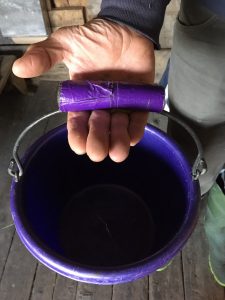Revisiting Cheesemaker Extraordinaire: Caitlin Hunter of Appleton Creamery
By Ellen S. Gibson
Caitlin Hunter has been making farmstead cheese since 1980. A pioneer cheesemaker, she helped to establish the Maine Cheese Guild, which today provides educational programming and advocacy for licensed cheesemakers who are producing world-class cheeses all over the state. Caitlin set the standard.
Making cheese is hard, physical work.
Some cheesemakers, like Caitlin, raise their own animals in addition to cheese making, so there are daily chores of lifting grain sacks, throwing hay bales, daily care for the animals and milking. The milk then has to be moved from the milking room, or point of delivery, to the cheese-making room. One gallon of milk weighs 8 pounds. Even a small cheesemaker processes hundreds of gallons of milk in a year. Consider, too, that the typical cheese pasteurizer vat for a small producer holds 35 gallons of milk. The milk has to get into the vat somehow—often in 5-gallon bucketfuls, lifted by hand. If there is no outgoing pipe, the whey from the cheese-making process will also be carried out by hand.
Ketra Crosson, an occupational therapist with Maine AgrAbility did an on-farm visit in March 2016. Caitlin was concerned about arthritis and was developing musculoskeletal injuries from all the lifting. Ketra made a number of recommendations to Caitlin to help reduce the stress on her joints and muscles, including:
- Reduce stooping and reaching postures, particularly when handling heavy objects.
- Draw objects close to the body before lifting them.
- Organize storage to keep heavier, frequently used items within the most comfortable zone of reach, above the knees and below the shoulders.
- Review working heights for good posture and back health. The height of workstations appropriate for one worker may not be right for shorter or taller coworkers.
- Consider electric pumps and hoses to transfer liquids between containers when possible.
- Use a wheeled cart or dolly to move heavy items from one area to another.
- Use a sit/stand stool is useful for tasks that require long periods of standing.
- Use anti-fatigue mats to help reduce leg strain.
- Take rest breaks every 30 to 45 minutes to help manage musculoskeletal disorders.
We met up with Caitlin recently to check-in and ask a few questions.
Did you find the recommendations from AgrAbility helpful?
Yes, all Ketra’s recommendations were helpful. And I preach it to the next generation, and sing the praises of AgrAbility!”
When Ketra asked you to name your biggest challenge as a cheesemaker, you said, “Aging. Every year the physical challenges are greater. How much can I lift, and how far can I carry it? Every year we have to rethink how we do things.” What are some examples of your rethinking?

This year, I hired a farm manager (my niece) who is in charge of all things animal-y and all things heavy. I simply cannot lift anything anymore. So, I am not milking at all.
My niece has rearranged my systems for her comfort, to the point where if I had to milk, I couldn’t. She doesn’t use skateboards to move the milk can, she fills the milk can too full, and she hangs the milk lines too high. But I don’t have to do it anymore, so it’s all moot. Everyone loves the fat handles on the buckets, though!
I do step in and scold her and my other apprentices when I see them lifting too much weight.
My cheese room helpers lift all the buckets of whey for me, and fill the pasteurizers, and make the cheese in the big vat. If I have to do anything by myself, I only fill the buckets halfway (two gallons).
We have rearranged everything heavy to lower shelves, and I have a step stool I use to get as close to things as possible to reach them. I scold everyone for putting things up too high. It’s just too tempting to fill an empty shelf.
In the dairy, I am using janitor’s bucket wheels to move the buckets of curd around the room. They are very handy.
I now have a mail order and CSA packing fulfillment area!
You did everything: taking care of the goats, breeding, milking, making cheese, marketing. (You didn’t bale your own hay.) How did you manage it?
I have no idea how I did it all myself, other than I was in my 40s and 50s. It’s been more difficult in my 60s. In the early days I could depend on my husband, Brad, to build and fix things. His health has declined in the last five years—he has Parkinson’s and a blood disorder—and he is unable to help on the farm now.
It’s hard to do this kind of work without a partner, whether they are actually participating or just supportive. If you lose the actual physical contribution of a partner, it’s the beginning of the end.
I didn’t know you are planning to retire this year. How do you envision this transition?
The best-case scenario is for my niece to buy the farm. I hope a former apprentice will buy the business/brand. I will advise the cheese successor for a year as they transition. They will have the option to make cheese here while they build out their new location.
Brad and I need to move to town by the winter. He needs to be closer to medical services. I need to get off my feet. I hope I can get my knees fixed soon.
e.g. Stay tuned for Part II of this interview with Caitlin, coming next week. We discuss her role in the Maine Cheese Guild and recommendations to cheesemakers on planning the infrastructure of their processing facilities.
